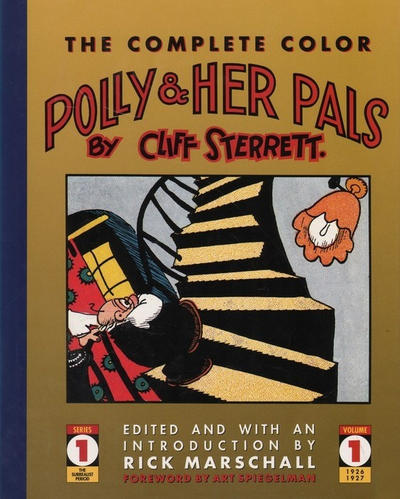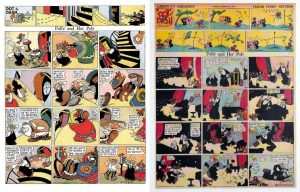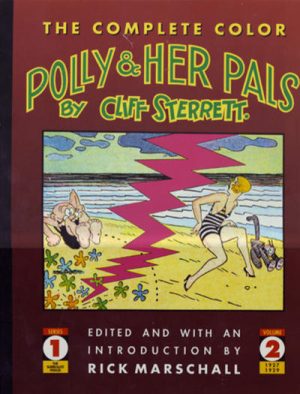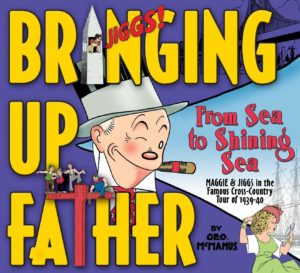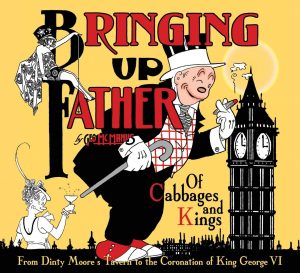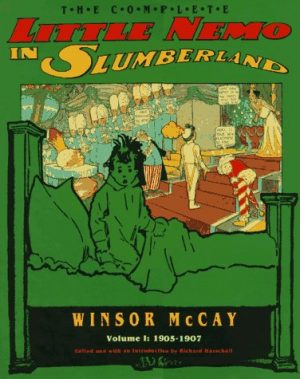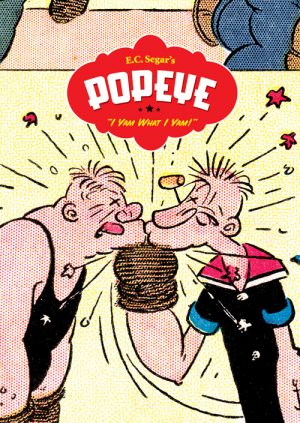Review by Frank Plowright
By 1926 Cliff Sterrett had been producing the daily social comedy of Polly & Her Pals for over a decade, expanding the black and white single tier to a full colour page for Sunday newspaper publication. Somewhere in the previous year, though, inspiration struck, and long before modern art registered in the consciousness of middle America, Sterrett was supplying surrealism, cubism, art-deco and abstraction on a weekly basis. Combined with a strong sense of colour and graphic design, Sterrett’s Sunday pages from the mid-1920s rank with the greatest newspaper strips of all time.
While young socialite Polly is the title personality, her participation in the Sunday strips is secondary to her father’s slapstick mishaps. Sam’l “Pa” Perkins is wealthy, but bumbling, and prone to misunderstandings, representative of a type now relegated to black and white films, and a vehicle for jokes relating to his personality. Skilfully constructed, some still prompt a laugh, while others now seem contrived, although allowance should be accorded for Sterrett possibly originating gags now tired through overuse.
We’re not here for the gags, though. Sterrett already has some signature artistic techniques in place by the earliest 1926 pages. A constant design element is people in bright checked clothes, the family cat is an accumulation of simple shapes, and people don’t walk, they stride, the soles of their shoes on display. Robert Crumb paid attention. When she does appear, Polly is draped in the latest fashions and hairstyles, and the household objects are always distinctive and decorative. Sterrett gradually adds more comedic elements, such as people walking in pairs choreographed in syncopation. In the summer 1926 seaside strips the waves are constructed from sharp jagged lines, and before then there’s a strip with blobs of bright colour in black panels otherwise only showing faces. Even by his experimental standards the hallucinogenic distortions of the left sample strip are an astonishing leap, and by the 1927 right sample strip Sterrett is serving knockabout comedy in bold areas of black ink.
To state that every single strip here is innovative and inspirational would be to exaggerate, although every single strip is well crafted and exceptionally composed with the drawing of the highest standard. The collection is a showcase of Sterrett’s gradual progress into more startling graphics and it’s with Volume 2 that the innovation is sustained. Be warned a few pages display the now offensive attitudes of the times. Pa has a Chinese servant whose English dialogue is stylised for laughs, and it’s unfortunate that the opening strip concerns Pa and his mates in blackface for a minstrel show.
This 1990 publication and the 1991 Volume 2 were issued before the age of digital reconstruction, so the art is reproduced from the best copies available to compiler Rick Marschall, yet it’s only an occasional page where the presentation is less than desirable. Library of American Comics’ bulkier 2010 volumes offer sharper reproduction.
